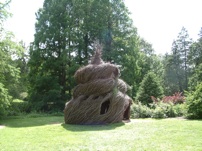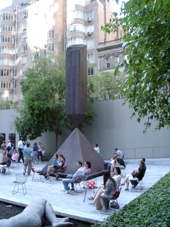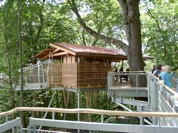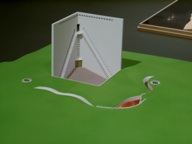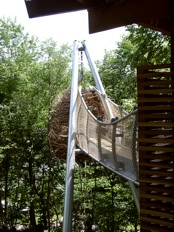arslocii
placeness as art


arslocii
placeness as art





















Quest for artistic endeavor in
the Lehigh Valley, PA; New York City;
and the New York Highlands
Again, the idea was to take short-distance excursions that would last one day. Sometimes we could fit in a couple of sites or, in the case of a rich source like New York City, we could tour a number of offerings in the same locale. We took Bolt Bus to New York and, although it is a bus and it has to deal with traffic, it is so much better than Greyhound – even though they have the same ownership. Storm King was a long day of driving to and fro, but in between it was a joy. A few hours spent there, though, is not enough. We bicycled to Morris Arboretum – only a handful of miles from our house – and we did almost the entire trip on noncar paths. Talk about transportation options!
Storm King Sculpture Center
Mountainville, NY
(not permitted to publish images)
Twenty-something years ago we visited this mother of all sculpture parks when its feel and visual imagery were indelibly etched into our consciousness. It has been the inspiration for arslocii as well as the source of our thoughts about art, landscape and nature combinations in general, a touchstone that has lived in remembrance – until now. We had to return to recheck our memory card to make sure it wasn’t miscalculating the data. If our recollections were tainted or somehow embellished beyond reason, veiled in a rosy gauze, “nostalgicized,” romanticized, wrapped into a moment of circumstantial happiness, or, goddess forbid, no longer living up to our ever-increasing demand for experiential uber-standards – well, it would have ended our quest, in a way. So, this was a risky and exciting trip. Proving the pudding, in fact.
It did not disappoint. Au contraire. Not only was Storm King as magical as memory served, but also there is more there now to observe and absorb and wonder at. One such newer item is Andy Goldsworthy’s “Storm King Wall,” a piece we had read about and seen a bit of in his film, “Rivers and Tides.” The man knows how to relate to nature. And that is something rare in artists, we’re finding. The way we approached the piece, from the westernmost edge where it abruptly stops (or begins) at the highway fence dividing the Storm King land from the New York State Thruway (you could feel the breeze from the speeding cars), is a great starting point (it turns out). There it just looks like a wall, a dry-stacked fieldstone pasture wall that cuts straight across an open piece of flat land. It has a couple of openings in it, one with a gate, and it all looks very much as it does on other farm acreage in the surrounding valley. As you follow it, the wall suddenly rushes like a train down a long steep embankment, after shimmying between a pair of trees. Not so normal now. After the drop, the wall crosses a road where it breaks again, recommencing on the other side and continuing its descent toward a lake, then disappearing into the water. Across the lake, the wall emerges like some medieval serpent with its tail the part we saw first. The wall takes the short cut through the lake; we have to walk around the water to cross and follow in pursuit of the wall. On the other side, it is wooded and shady as opposed to the open sunny pasture where it all started. Now the wall is ascending the woodland bank and it uses the trees as footholds, weaving, undulating, slithering around them, really, on its way up the rise – curling and coiling and climbing. There is lovely interplay between the wall and its arboreal hosts. In one place the tree is actually built into the wall. There is humor, there is beauty, there is a perfect balance. In this one work we have arslocii defined.
But it isn’t just about the wall. Maya Lin has recently installed an earthwork called “Storm King Wavefield,” viewable from above (it’s in a land bowl) but also accessible by walking through its valleys. Since it is just growing into its environment, we’ll reserve judgment for the next visit. Richard Serra has some large steel sheets (what else?) wedged into the contoured landscape, and it is amazing how the contrast of the straight and level can reveal so much about its context, the land. And what a landscape it is! Mountains surround the park, and the rolling hills both obscure and accentuate the artwork. Mark di Suvero never had a better showplace than this place – his work has a valley unto itself, and some of his structures actually mimic the land in an abstract way. Robert Grosvenor’s “Untitled.” a large bowed steel piece, is one of the vivid memories of our first visit here. It is being restored on this visit but its power is still palpable, a kind of bridge-like minimal form, spanning a low-lying meadow. For us, it spans the distance between art and nature. It could be the poster child for Storm King.
There is so much here at Storm King – natural splendor, landscaped meadows and paths, and some of the world’s best large-scale sculpture. What’s not to like? The key is the blend, and it has been so integrally executed at this place that, at times – most times – there is the sense that everything, the mountains and the art, sprang full-blown from the heads of the gods on Mount Storm King. Thank you, William A. Rutherford, the visionary landscape architect who seamlessly knitted it together.
Sound Art: Times Square, Central Park, Paley Park
New York City
Previously, when we visited New York City, we were on a quest for visible art. This trip’s theme was audible art. The first stop was someplace we had walked over maybe hundreds of times when in Times Square. On and underneath a pie-slice wedge of a traffic island, covered mostly with subway grating, is the site of the appropriately named “Times Square,” a sound installation by Max Neuhaus. Millions of passers-by trod over it every day, probably not noticing it in the din of midtown traffic. But when you listen for it, it is quite a lovely sound: harmonic waves, low tones like those of a bass pan-pipe or a Tibetan Buddhist Rag-Dung ritual long horn – sustained, monotone, the tambura sound in a Philip Glass piece, or the wind. One could easily mistake it for the rushing aftermath sound of just-passed or -approaching subway trains, but it is too melodic. Owned by Dia, of course, this is subtlety below the fray.
The next audio artwork, called Sound Tunnel, is in Central Park in – guess what? – a tunnel. The yellow-brick pedestrian pass-through, north of the Central Park Zoo, is a busy thoroughfare located directly behind the Delacorte Clock, which chimes every thirty minutes playing nursery-rhyme tunes, and which certainly stands out aurally in the competition for walkers’ ears. On one side of the arch there are six speakers mounted in a line (looking like a thin and early Donald Judd sculpture) about ten feet above the ground. As with Neuhaus’ piece, most people are unaware of the sound because of their own emanations. The composer, John Morton, collected specimens or sound snippets and created a montage/collage of human and animal noises – sort of what a soundman does for films, but in that instance in service to a larger narrative construct. We will call this collection, for lack of a title, “Sounds of Summer,” since what was heard included baseball, horse races, singing, chanting, poetry, bird calls, construction workers, jungle chatter and a sprinkler. A quote from the artist: “It’s a noise show....” Yes, it is.
Paley Park is a work of art on several levels. That it is so small but so expansive is one. Second, that being in it transports the visitor to a whole other place, so alien to its surroundings, that it feels like a breech in the space-time continuum. (Designed in 1967 by Zion & Breen for William Paley of CBS fame, it is only one tenth of an acre.) What it does, it does so simply and so completely. A description: a gated narrow space between tall buildings made up of three walls – two ivy covered, one a waterfall; canopied and shaded by a dozen spindly honey locust trees; cobblestone floor; several scattered Bertoia wire chairs and tables. It is a beautiful space. But it is also a sound space, creating the power surge of water rushing like Niagara down a twenty or so foot drop of rock-face. Its effect is that it obliterates all other sound, even the relentless pulsing traffic on 53rd Street. It is a small chapel to tamed nature in an unnatural setting. It can save your soul.
MoMA
New York City
MoMA’s sculpture garden is a bit of a shoebox-sized courtyard on the side of the museum. It is design-y – like Jacque Tati’s 1958 stylized “Mon Oncle” garden – only this one has more plants. A nice textural mix of sculpture, trees, ivy, marble and water in conjunction with the surrounding walls of glass of every description – transparent, opaque, black, frosted – mixed with concrete panels and stainless-steel slatted gates. The space is sensual in a minimalist way. And then there’s what you gaze up at – Beaux Arts rooflines, Art Deco towers with streamlined terrace railings, blond brick curves and faceted balconies, and the finial atop the AT&T building. There is interplay between the architectural sculpture outside the enclosure and the sculptural objects within. The sounds of the city are muffled a bit in here but are still present. The water helps. But tonight there is music in the garden – group drumming. A perfect way to alter a space: by sound.
Arslocii went to MoMA for two reasons. The second was to see a show called, “In Situ: Architecture and Landscape,” a show meant to explore “the relationship between built environment and surrounding landscape.” This seemed right up our alley. It was a show of drawings, renderings and models of residential and commercial projects by some of the heavy hitters of 20th-century architecture. Considering the title of the show, we would have expected more of a presence of landscape architects but could find only one, Roberto Burle Marx. Despite the interest in seeing models of some well-known modernist structures like the Lovell House, Wolf House, Fallingwater, etc., these 3-D renderings made us sad that the balance that arslocii seeks was not prevalent, as we had hoped from the show’s title. Typically, the structures overwhelmed the sites. There might have been the concept of utilizing the sites creatively and/or profiting from the advantageous views from the sites, but rarely was there a blending of site and structure. The rare exceptions were the model for (and the reality of) Fallingwater, and the “Garden Design Saenz Pena Square” of Burle Marx, because he actually works with the land. It just goes to prove, once again, how essential landscape architects are.
Morris Arboretum
Philadelphia, PA
Always a special place, this once private collection of trees and gardens is a pleasurable visit any time of the year. Personally, I have always wished that there was a little more hardscape to balance the landscape. Remember, that’s the significant pairing in arslocii that can potentially transcend both. The Morris is, on its face, an English park in the 19th-century style, with all the “stations,” including fountains, follies, ponds, woodland walks and a grotto. Bringing the park into the 21st century now is a newly constructed feature called “Out on a Limb.” We went there on its opening day, the Fourth of July. The first thought seeing it is that it is sculptural; a rib-cage like tunnel makes you feel as if you are entering the mouth of a whale. But it is a human-propelled escalator of sorts, a ramp that you walk up to the viewing platform, up into the midst of a grove of maples and oaks. Airborne now, you can look up into the canopy of foliage, down at the forest floor, and get up close and personal with trees. Cantilevered out and swinging gently on a hook is the human scale version of a bird’s nest, made from branches rather than twigs. There is a pavilion possessing Asian elements of a teahouse in the woods. Also on deck, the sense of a tree house or the crow’s nest of a ship: ropes and rigging and a wooden floor. You can’t help but make an association to high rope bridges that span deep gorges in the jungle. It’s very well-conceived and has a good balance with its environment, built in among the trees.
The other destination is the Morris’ Butcher Sculpture Garden. An installation called “The Summer Palace,” by Patrick Dougherty, was constructed in the spring out of twigs and saplings from a variety of trees: willow, maple, birch, and dogwood. At 25’ it towers but it also is dwarfed, to a certain extent, by the surrounding landscape. Viewing its exterior, it resembles either a turban or turbine, or an upside down tornado. Or it could be the least-likely-to-succeed house of The Three Little Pigs. The best part is the inside – a cocoon-like spiral of tunnels, interior cells of a hive that are structural and that allow for occasional windows out to the environment. The smattering of filtered light that enters through the woven fabric walls, in addition to the few openings, creates an atmosphere of captured space in the larger environment. Not meant to be permanent, it is biodegradable and is probably more of interest for its materials than its artfulness.
Coplay Cement Company Kilns
Coplay, PA
Although coming here was part of a look-see at several sites in and around the Lehigh Valley, these artifact towers were the highlight of the day. Not easy to locate and certainly not overrun with tourists, the sight of these medieval-looking chimneys (once towering at 90’, reduced by one third in the 1920s, but still looming) is strange indeed. Now, standing like nine votive figures waiting for the return of their active lives, which was from 1893 to 1904, their arched openings resemble the hopeful and patient faces of the Easter Island statues. Originally, they mostly stood within the walls of the factory building that was demolished in the 1920s; the site has been turned into a county-owned park with a recreation area up a hill from the towers. A Danish modification of a German design, called Schoefer kilns, they were adapted and built from locally manufactured red brick for the production of portland cement. They are situated close to the Lehigh River but the tree-cover prevents you from seeing it. The fact that they are built into a sloping terrain adds to their mystery, emphasizing their relationship to and power within the landscape. Better than some site-specific artwork, these weathered totemic reminders of an industrial past become sculptural elements in their new found non-functional role. Coplay should take better care of them.
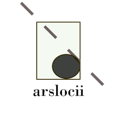
arslocii, a creation of Probasco Haus Press
copyright © 2010 Probasco Haus Press LLC






Top Left: Coplay Cement Company Kilns.
Bottom Left: Morris Arboretum, The Summer Palace by Patrick Dougherty.
Right:Paley Park, looking in from the street.
